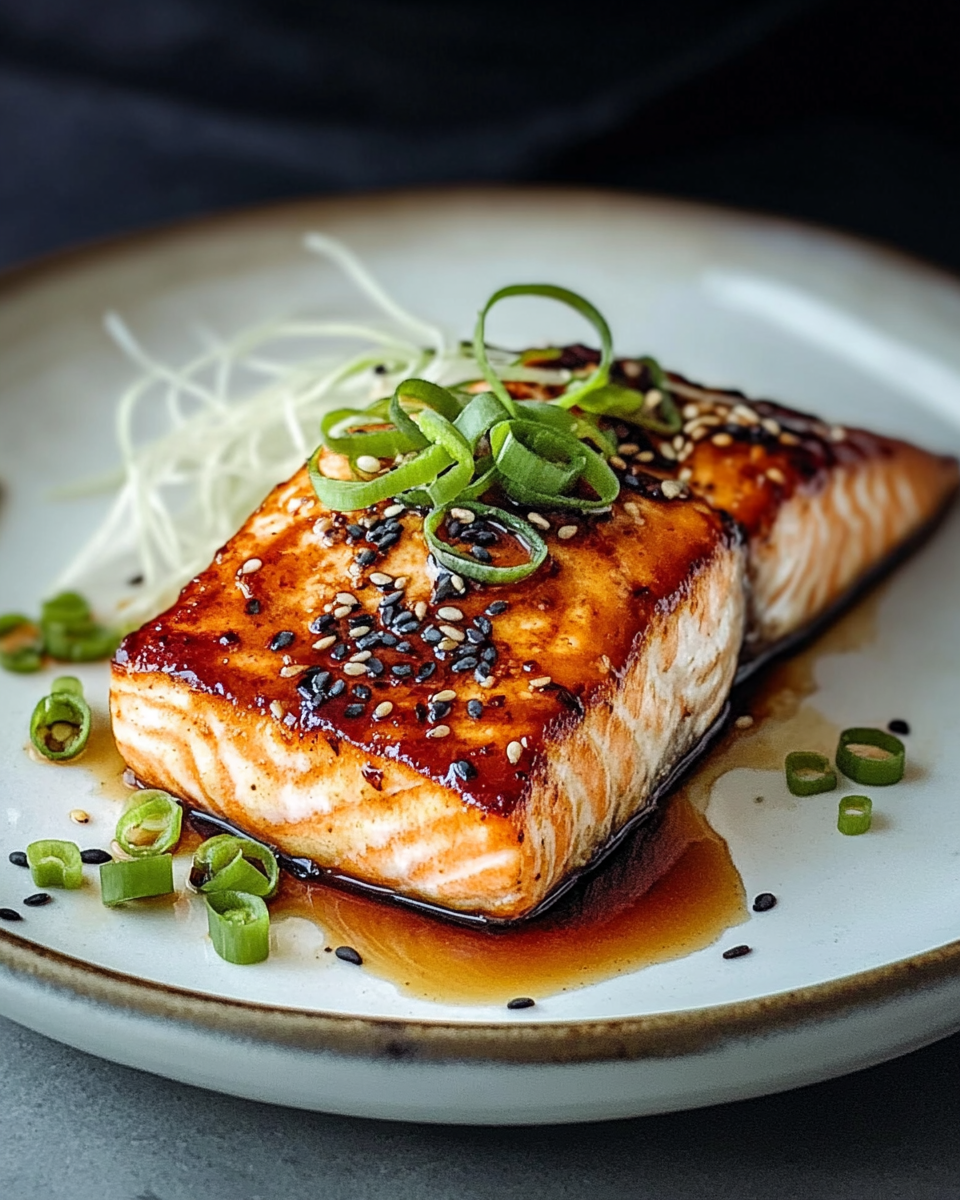The caramelized Nobu-style Miso Salmon is a show stopper, delivering the perfect harmony of sweet, savory, and umami flavors. This dish takes its inspiration from the legendary Nobu Matsuhisa, bringing the elegance of fine Japanese dining into your own kitchen.
With a simple miso-based marinade enriched with sake, mirin, and fresh ginger, this recipe transforms humble salmon into a buttery, flavor packed main course. Whether you’re hosting guests or indulging solo, this miso-glazed masterpiece will impress every time.
Full Recipe:
Ingredients:
-
4 salmon fillets (6 oz each)
-
1/3 cup white miso paste
-
1/4 cup mirin (sweet rice wine)
-
1/4 cup sake
-
3 tbsp granulated sugar
-
1 tbsp soy sauce
-
1 tbsp sesame oil
-
1/2 tsp grated fresh ginger
-
2 green onions, sliced (for garnish)
-
1 tsp toasted sesame seeds (for garnish)
Directions:
-
In a saucepan over medium heat, combine miso paste, mirin, sake, sugar, soy sauce, sesame oil, and ginger. Stir until smooth and simmer for 2–3 minutes. Let the marinade cool.
-
Place salmon fillets in a shallow dish and coat evenly with the marinade. Cover and refrigerate for at least 2 hours or overnight for best results.
-
Preheat the oven to 400°F (200°C).
-
Line a baking sheet with parchment paper. Shake off excess marinade and place salmon fillets on the sheet.
-
Bake for 10–12 minutes. Switch to broil mode and cook for an additional 2–3 minutes until the top is golden and caramelized.
-
Remove from oven, garnish with green onions and sesame seeds, and serve immediately.
Prep Time: 10 minutes | Marinating Time: 2–24 hours | Cooking Time: 15 minutes | Total Time: ~2 hours 25 minutes
Kcal: 350 kcal | Servings: 4 servings
The Art of Nobu-Style Miso Salmon: A Japanese-Inspired Masterpiece
Few dishes capture the harmony of simplicity and sophistication like Nobu-style Miso Salmon. Inspired by the iconic dish from the globally renowned Chef Nobu Matsuhisa, this culinary creation fuses delicate Japanese flavors with a universal appeal. It’s become a staple not only in high-end dining establishments but also in modern home kitchens, where food lovers seek to replicate gourmet experiences with accessible ingredients and techniques.
Nobu style Miso Salmon is more than just a recipe; it’s a symbol of how cross-cultural cuisine can transcend borders. This dish marries traditional Japanese miso with Western-style cooking methods, creating a deeply flavorful meal that’s both elegant and easy to prepare. In this article, we’ll explore the origins of the dish, its flavor profile, cooking strategies, health benefits, and pairing ideas, culminating in a compelling case for why every home cook should master this salmon sensation.
Origins: From Tokyo to the World
The miso-marinated fish concept was popularized by Chef Nobu Matsuhisa, a Japanese chef celebrated for blending classical Japanese techniques with Peruvian influences. The original version of this dish featured black cod (sablefish), famously known as “Black Cod with Miso,” and debuted at Nobu’s restaurant in the 1980s. It quickly became one of the most beloved items on the menu and an international sensation.
As the demand for similar flavors grew, chefs and home cooks began experimenting with other fish, notably salmon, which is more widely available and equally rich in flavor. Salmon’s buttery texture and oil content make it a perfect candidate for miso marination, absorbing the umami-rich glaze while holding its shape during cooking. Thus, Nobu-style Miso Salmon was born a luxurious, yet approachable adaptation of a modern classic.
The Flavor Profile: Sweet, Savory, and Umami
What makes this dish irresistible is its profound flavor complexity. The marinade combines miso paste a fermented soybean product with sweet and acidic elements like mirin (sweet rice wine) and sake, enhanced with sugar and soy sauce. The result is a rich glaze that clings to the surface of the fish, developing a deep umami flavor when cooked.
As the salmon roasts or broils, the sugars in the marinade begin to caramelize, forming a golden-brown crust on the exterior. This outer crisp contrasts beautifully with the tender, flaky interior of the salmon. The fermentation in the miso adds a subtle tang, while the mirin and sugar offer balance with a pleasant sweetness. Together, they create a culinary trifecta of flavor: sweet, salty, and savory.
It’s not just the taste that captivates it’s the aroma. As the salmon cooks, the scent of caramelizing miso fills the kitchen, signaling that something truly special is about to be served.
Cooking Techniques: Precision Meets Simplicity
One of the best aspects of Nobu-style Miso Salmon is how easy it is to make, despite its gourmet allure. While many restaurant-quality dishes require elaborate steps or advanced tools, this recipe keeps things simple, relying on proper marination and precise cooking.
The marination process is essential to its flavor. Allowing the salmon to rest in the miso mixture for at least a couple of hours—and ideally overnight gives the fish time to absorb the flavors fully. The marinade seeps into the salmon, infusing it with complexity and ensuring that every bite is packed with depth.
Cooking is typically done in two phases: baking followed by broiling. Baking ensures even cooking, keeping the salmon moist and tender, while a short broil finishes it with a caramelized glaze. This method maximizes the flavor and visual appeal without drying out the fish.
The key to perfection lies in timing. Overcooking can ruin the delicate balance of flavors and textures, so it’s essential to monitor closely during the broiling stage. The sugars in the marinade can quickly go from caramelized to burnt, so watch for that golden-brown finish and pull the salmon out just in time.
Choosing the Right Salmon
Not all salmon are created equal, and the type of salmon you use can significantly impact the final result. Wild-caught varieties such as King (Chinook) or Sockeye salmon are ideal, offering a higher fat content that works beautifully with the miso marinade. Their natural richness pairs well with the glaze and helps the fish stay moist during cooking.
If you’re opting for farm-raised salmon, choose responsibly sourced options with firm, bright-colored flesh. Sustainability and quality sourcing are important, especially when making a dish where the main protein plays such a starring role.
Pairing Suggestions: Creating a Complete Meal
The beauty of Nobu-style Miso Salmon is its versatility. While the dish shines on its own, pairing it thoughtfully can elevate the meal into an unforgettable dining experience. Traditional Japanese accompaniments work best, as they complement the flavors without overwhelming them.
-
Steamed White Rice – The classic pairing. The neutral flavor of rice balances the intensity of the miso glaze and soaks up the juices from the salmon.
-
Sautéed Greens – Vegetables like bok choy, spinach, or snow peas, lightly stir-fried in sesame oil and garlic, add freshness and texture.
-
Miso Soup – Reinforces the central theme of miso and offers warmth and umami in a liquid form.
-
Pickled Vegetables – Something acidic, like pickled daikon or ginger, cuts through the richness and refreshes the palate.
-
Asian-Inspired Slaw – A crunchy, tangy slaw with rice vinegar and sesame seeds brings contrast and color to the plate.
Health Benefits: Flavor Meets Function
This dish isn’t just delicious it’s also packed with nutritional benefits. Salmon is one of the best sources of omega-3 fatty acids, which are essential for heart and brain health. It’s also high in protein, B vitamins, and selenium.
Miso, made from fermented soybeans, is a probiotic food that supports gut health. It’s rich in minerals like zinc and copper and contributes to immune function. Despite its salty profile, when used in moderation, miso adds significant health value.
The marinade’s natural ingredients like ginger and sesame oil offer anti-inflammatory properties and support digestion. Put simply, this dish is a powerhouse of nutrients that nourishes the body as much as it delights the senses.
Variations and Customizations
While the original recipe is exquisite, there’s plenty of room for creativity. Home cooks can tweak the marinade based on what’s in their pantry or personal taste preferences.
-
Swap Sugars – Replace white sugar with honey or maple syrup for a different kind of sweetness.
-
Add Heat – A touch of chili paste or fresh red pepper flakes can introduce a spicy kick.
-
Vegetarian Version – Use the same miso marinade on firm tofu or eggplant for a meatless alternative.
-
Grilled Option – Instead of baking and broiling, throw the marinated salmon on the grill for a smoky twist.
-
Sushi Bowls – Flake the cooked salmon over sushi rice with avocado, cucumber, and nori for a deconstructed sushi bowl.
These adjustments maintain the dish’s core essence while letting the cook personalize it to suit dietary needs or ingredient availability.
Conclusion:
Nobu style Miso Salmon represents the best of modern cuisine deeply rooted in tradition, yet easily adaptable to contemporary kitchens. It’s proof that gourmet flavors don’t have to be complicated. With a few quality ingredients and thoughtful preparation, anyone can recreate this restaurant-caliber dish at home.
Whether you’re looking to impress dinner guests or simply elevate a weeknight meal, this miso-glazed salmon is a recipe that delivers every time. It’s flavorful, healthy, and endlessly satisfying a celebration of Japanese simplicity and culinary excellence. Once you’ve tasted it, you’ll understand why this dish has earned a permanent place in the hearts (and kitchens) of food lovers around the world.

